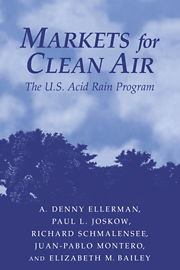Book contents
- Frontmatter
- Contents
- List of Illustrations
- List of Tables
- Preface
- Acknowledgments
- Part I Background
- Part II Compliance and Trading
- Part III Questions and Implications
- 10 Cost Savings from Emissions Trading
- 11 Errors, Imperfections, and Allowance Prices
- 12 Concluding Observations
- Appendix: Effect of Title IV on SO2 Emissions and Heat Input by Susanne M. Schennach
- Bibliography
- Index
12 - Concluding Observations
Published online by Cambridge University Press: 10 December 2009
- Frontmatter
- Contents
- List of Illustrations
- List of Tables
- Preface
- Acknowledgments
- Part I Background
- Part II Compliance and Trading
- Part III Questions and Implications
- 10 Cost Savings from Emissions Trading
- 11 Errors, Imperfections, and Allowance Prices
- 12 Concluding Observations
- Appendix: Effect of Title IV on SO2 Emissions and Heat Input by Susanne M. Schennach
- Bibliography
- Index
Summary
The U.S. Acid Rain Program – Title IV of the 1990 Clean Air Act Amendments – was passed by Congress and signed by President Bush to reduce SO2 emissions that contribute to acid rain. Neither Congress, nor President Bush, nor most of Title IV's other supporters conceived of the program as a policy experiment. Our analysis indicates that the Acid Rain Program has thus far been a notable success. Title IV more than achieved the SO2 emissions-reduction goal established for Phase I, and it did so on time, without extensive litigation, and at costs lower than predicted. Moreover, there has been 100% compliance by all affected sources. Not only have there been no violations of the law, but no administrative exemptions or exceptions have been granted to permit noncompliance. After all, no affected source has been able to claim that compliance would be a special hardship, since it could always meet its compliance obligations simply by purchasing allowances on the open market. We are unaware of any other U.S. environmental program that has achieved this much, and we find it impossible to believe that any feasible alternative command-and-control program could have done nearly as well. This performance justifies emission trading's recent emergence as a star on the environmental policy stage.
But, just as no single actor can excel in all roles, neither emissions trading nor any other approach to environmental policy can provide low-cost solutions to all environmental problems.
- Type
- Chapter
- Information
- Markets for Clean AirThe U.S. Acid Rain Program, pp. 314 - 322Publisher: Cambridge University PressPrint publication year: 2000



